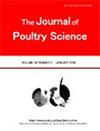Effects of Observed Incubation Behavior on Egg Production in Laying Hens of a Commercial Chicken Breed and Detection of Single-Nucleotide Polymorphisms Associated with the Incubation Behavior
IF 1.6
4区 农林科学
Q2 AGRICULTURE, DAIRY & ANIMAL SCIENCE
引用次数: 0
Abstract
Upon contact with laid eggs, avians initiate incubation behavior and stop laying additional eggs. This phenomenon suggests that the productivity of laying hens in free-range facilities may decrease because of frequent contact with laid eggs. Here, we examined whether hens of a commercial breed exhibit incubation behavior in a free-range facility and whether egg productivity subsequently decreases. One-hour observations were performed twice weekly for 3 weeks, during which 9 of 129 hens (7.0%) exhibited incubation behavior (i.e., sitting on eggs) in the free-range facility and were defined as incubating hens. During 4 d of continuous behavioral observation, incubating and non-incubating hens laid the same number of eggs statistically (4.6 and 3.6, on average, respectively); however, incubating hens spent significantly more time on average incubating the eggs (2071.9 min) than did the non-incubating hens (20.9 min; P<0.05), indicating a clear behavioral difference. Subsequently, the incubation behavior and egg productivity of incubating hens and a Silkie Fowl breed hen, which is known to exhibit typical incubation behavior and cessation of laying, were continuously compared for 27 d. The average minutes spent incubating eggs during the observation period increased in both the incubating hens and Silkie Fowl hen and the total time was almost the same (18,088.5 and 23,092 min, respectively). However, the Silkie Fowl hen stopped laying on day 17 after laying 17 eggs, whereas the incubating hens continued laying throughout the observation period. Incubating hens laid an average of 24.5 eggs, indicating that some hens (at least those of the commercial breed used in our study) can continue laying while exhibiting incubation behavior. A single-nucleotide polymorphism associated with incubation behavior was detected on chromosome 4 through genome-wide association analysis.观察到的孵育行为对某商品鸡种蛋鸡产蛋量的影响及与孵育行为相关的单核苷酸多态性检测
一旦接触到产卵,鸟类就会开始孵化行为并停止产卵。这一现象表明,由于频繁接触鸡蛋,散养设施中蛋鸡的生产力可能会下降。在这里,我们研究了商业品种的母鸡是否在自由放养设施中表现出孵化行为,以及鸡蛋产量是否随后下降。每周进行两次为期3周的1小时观察,期间129只母鸡中有9只(7.0%)在自由放养设施中表现出孵化行为(即坐在蛋上),并被定义为正在孵化的母鸡。在连续4天的行为观察中,孵育和未孵育的母鸡产下的蛋数在统计学上相同(平均分别为4.6和3.6);然而,孵育母鸡平均孵育鸡蛋的时间(2071.9分钟)明显多于未孵育母鸡(20.9分钟;P<0.05),这表明有明显的行为差异。随后,对正在孵育的母鸡和已知表现出典型孵育行为和停止下蛋的丝鸡品种的孵育行为及产蛋率进行了27天的连续比较。在观察期内,孵化母鸡和丝羽母鸡的平均孵化时间都有所增加,总时间几乎相同(分别为18088.5和23092分钟)。然而,丝鸡在产下17个蛋后于第17天停止下蛋,而孵育的母鸡在整个观察期内继续下蛋。孵化母鸡平均产下24.5个蛋,这表明一些母鸡(至少是我们研究中使用的商业品种的母鸡)可以在表现出孵化行为的同时继续产卵。通过全基因组关联分析,在4号染色体上检测到与孵化行为相关的单核苷酸多态性。
本文章由计算机程序翻译,如有差异,请以英文原文为准。
求助全文
约1分钟内获得全文
求助全文
来源期刊

Journal of Poultry Science
AGRICULTURE, DAIRY & ANIMAL SCIENCE-
CiteScore
2.80
自引率
13.30%
发文量
26
审稿时长
12 months
期刊介绍:
The Journal of Poultry Science will publish original reports and reviews which either make an original contribution to fundamental science or are of obvious application to the industry. Subjects which are covered include: breeding and genetics, nutrition and feeds, physiology, reproduction, immunology, behavior, environmental science, management and housing welfare, processing and products, and health in poultry. Submission of original articles to the Journal is open to all poultry researchers. The review articles are invited papers written by international outstanding researchers. Articles will be published in English, American style.
 求助内容:
求助内容: 应助结果提醒方式:
应助结果提醒方式:


